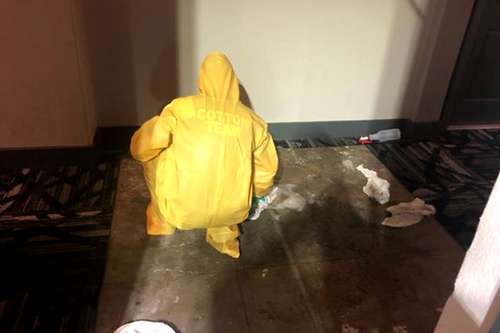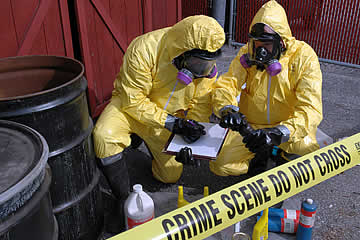Clandestine Lab Cleanup: Comprehensive Purification for Hazardous Sites
Clandestine Lab Cleanup: Comprehensive Purification for Hazardous Sites
Blog Article
Professional Biohazard Cleaning and Decontamination for Blood, Bodily Fluids, and Hazardous Materials
The prospective wellness risks linked with direct exposure to biohazards underscore the critical demand for careful handling and complete clean-up. As we browse the elaborate landscape of biohazard cleaning, comprehending the subtleties of policies, compliance, and the customized equipment at play becomes vital in ensuring a secure and thorough decontamination procedure.
Health And Wellness Dangers of Biohazard Direct Exposure
Exposure to biohazards presents substantial health and wellness dangers that can result in extreme consequences for areas and individuals alike. Biohazards encompass a wide variety of organic compounds, consisting of blood, bodily fluids, mold, germs, infections, and other potentially contagious products. When people enter contact with these biohazards, whether via mishaps, inappropriate handling, or ecological exposure, they face the threat of contracting serious health problems or illness.
Among the primary health threats related to biohazard exposure is the transmission of contagious diseases. Bloodborne pathogens such as HIV, hepatitis B and C, and various germs can be existing in biohazardous materials, positioning a straight risk to human health. Breathing in airborne biohazards like mold spores or entering call with infected surface areas can additionally cause respiratory problems, allergies, and various other damaging wellness impacts.
Moreover, biohazard direct exposure can have long-term wellness ramifications, with some illness materializing years after the preliminary call (Blood Cleanup). For that reason, it is vital to focus on appropriate biohazard cleansing and purification to alleviate these health risks and make sure the security of people and areas

Specialized Educating for Biohazard Cleaning
When it comes to handling biohazard cleanup effectively and securely, specialized training plays a fundamental function in guaranteeing correct purification procedures are adhered to. Biohazard cleaning calls for particular expertise and abilities to efficiently reduce dangers linked with bloodborne virus, bodily liquids, and hazardous products. Professionals educated in biohazard cleaning undergo extensive guideline on exactly how to securely handle, get rid of, and throw away biohazardous products to stop contamination and exposure.
Specialized training for biohazard clean-up covers a variety of necessary topics, including proper individual safety equipment (PPE) usage, bloodborne microorganism understanding, decontamination methods, and contaminated materials disposal protocols. Individuals learnt biohazard clean-up are equipped with the required experience to analyze contamination degrees, identify potential dangers, and carry out suitable cleanup procedures in compliance with governing criteria.
Continuous training and education are paramount in the area of biohazard cleaning to remain upgraded on the most recent decontamination technologies, safety and security procedures, and laws. By investing in specialized training, biohazard cleanup specialists can efficiently react to emergency situation cleanup scenarios and protect both public health and the environment.
Importance of Correct Decontamination Strategies
Utilizing correct purification strategies is important in biohazard cleaning to efficiently remove dangerous materials and minimize health dangers. Efficient purification not only guarantees the removal of noticeable traces of blood, bodily fluids, and various other biohazards yet also targets undetectable pathogens that may pose major health risks if not appropriately gotten rid of. By following rigid decontamination protocols, trained experts can significantly minimize the danger of exposure to unsafe microbes, viruses, and germs that might cause conditions or infections.
Correct purification methods entail using customized equipment and disinfectants that are especially made to neutralize biohazards properly. Detailed cleansing and sanitation of infected locations are vital to stop the spread of pathogens and guarantee a secure atmosphere for owners. Furthermore, the proper disposal of biohazardous waste adhering to decontamination treatments is crucial in preventing contamination of other surfaces or individuals.

Equipment and Devices for Safe Clean-up
The proper tools and devices play a crucial function in guaranteeing the effective and secure clean-up of biohazardous products. When managing blood, physical liquids, or unsafe products, biohazard cleansing professionals depend on specialized gear to decrease direct exposure dangers and completely sanitize the damaged location. Personal protective equipment (PPE) such as gloves, safety glasses, coveralls, and masks are important to protect versus straight contact with potentially infectious materials. Furthermore, biohazard cleansing kits containing anti-bacterials, absorbent materials, and biohazard bags are used to safely include and get rid of of infected things. Blood Cleanup.
Advanced cleansing devices like hospital-grade anti-bacterials, HEPA-filtered top article vacuum cleaners, and misting machines are used to disinfect surfaces and get rid of biohazards properly. Specialized equipment such as sharps containers and biohazard garbage disposal containers are utilized to safely take care of sharp objects and biohazardous waste materials. By utilizing the ideal tools and devices, biohazard cleaning professionals can guarantee a comprehensive cleanup procedure that focuses on safety and security and lessens health dangers for both employees and occupants of the affected area.
Laws and Conformity in Biohazard Cleaning
Correct adherence to policies and conformity criteria is vital in biohazard cleansing to ensure the safety of both workers and the setting. Federal government companies such as OSHA (Occupational Security and Health Administration) and the EPA (Epa) have actually established specific standards for biohazard cleaning treatments to lessen health and wellness dangers and ecological contamination. These guidelines cover a variety of elements including the handling, transportation, and disposal of biohazardous materials, in addition to the essential training and safety devices required for employees associated with the clean-up process.
Biohazard cleansing firms should remain up-to-date with these laws to ensure that their operations fulfill the called for security criteria. Failure to abide with these guidelines can lead to serious effects, including fines, lawsuit, and endangering the health and wellness of individuals and the environment. By complying with stringent guidelines and compliance procedures, biohazard cleansing companies can properly alleviate risks and guarantee a extensive and risk-free cleanup procedure for all parties entailed.
Verdict
Finally, biohazard cleansing and purification need customized training, correct strategies, and adherence to guidelines. Direct exposure to blood, physical liquids, and harmful materials positions significant health and wellness dangers, making it crucial to use the ideal devices and tools for secure cleaning. By adhering to Home Page rigorous protocols and guidelines, experts can successfully reduce the dangers connected with biohazard exposure and make certain the security of both themselves and others.
As we browse the intricate landscape of biohazard clean-up, recognizing the subtleties of regulations, conformity, and the customized equipment at play comes to additional resources be necessary in ensuring a extensive and secure decontamination process. (Blood Cleanup)
When it comes to handling biohazard clean-up effectively and securely, specialized training plays a basic function in guaranteeing correct purification treatments are adhered to.Making use of correct decontamination methods is essential in biohazard cleanup to properly eliminate unsafe products and reduce wellness threats. Furthermore, biohazard cleansing packages including disinfectants, absorbing products, and biohazard bags are used to safely contain and get rid of of polluted things.
Federal government agencies such as OSHA (Occupational Safety and Health And Wellness Administration) and the EPA (Environmental Protection Agency) have actually developed particular standards for biohazard cleaning treatments to decrease wellness dangers and ecological contamination.
Report this page